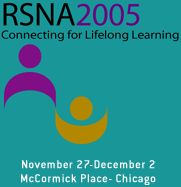
Abstract Archives of the RSNA, 2005
Tamami Namiki, Presenter: Nothing to Disclose
Ken Koyama MD, Abstract Co-Author: Nothing to Disclose
Hiroshi Tanaka MD, PhD, Abstract Co-Author: Nothing to Disclose
Mitsuhiro Ohmura MD, PhD, Abstract Co-Author: Nothing to Disclose
Junta Harada MD, Abstract Co-Author: Nothing to Disclose
Kunihiko Fukuda MD, Abstract Co-Author: Nothing to Disclose
Mayuki Uchiyama MD, Abstract Co-Author: Nothing to Disclose
Takuji Mogami MD, Abstract Co-Author: Nothing to Disclose
Kouichi Kishimoto MD,PhD, Abstract Co-Author: Nothing to Disclose
Yoshihisa Namiki MD,PhD, Abstract Co-Author: Nothing to Disclose
et al, Abstract Co-Author: Nothing to Disclose
It is difficult to detect prostate lesions on diffusion weighted (DW) images with common (<1000) b-factor(BF)s because of the influence of blood flow. To reduce this unfavorable effect and to detect lesions more accurately in patients with clinically suspected prostate cancer, we performed DW imaging with very high BFs (2000, 3000) before biopsy.
The study population consisted of 34 patients who underwent radical prostatectomy and 20 patients with benign prostate hypertrophy (BPH) confirmed by 2 biopsies and who had been followed up for over 8 months. All patients underwent MRI studies from January to December 2004. Imaging was performed with a 1.5T MRI system (Excelart, Toshiba, Tokyo). Axial T2 weighted images (T2Wi) and axial DW images were performed with FSE sequence and with multiple BFs (600, 1000, 2000 and 3000), respectively. Three radiologists, blinded to the pathological results, classified images into 6 categories (0: unreadable, 1: normal, 2: benign, 3: benign, but malignancy cannot be ruled out, 4: suspicious of malignancy, 5: highly suggestive of malignancy). These were compared with resected specimens or biopsy specimens and were analyzed by receiver operating characteristic (ROC) method. ROC curves were constructed for each following groups: a) T2Wi alone; b~d) T2Wi and DW imaging with a single BF (b) 1000; c) 2000; d) 3000); e~g) T2Wi and DW images with multiple BFs (e) 600 and 1000; f) 600, 1000 and 2000; g) 600, 1000, 2000 and 3000).
The areas under the ROC curve (Az) for each combination were a) 0.65, b) 0.73, c) 0.77, d) 0.72, e) 0.74, f) 0.81 and g) 0.81. This suggested that combination of T2Wi and DW images had a larger Az than T2Wi alone. Imaging with the single BF of 2000 showed larger Az than using other single BFs or multiple BFs less than 1000. Moreover, combination of T2Wi and DW images with sequential BFs (600, 1000, 2000 and /or 3000) had the largest Az.
DW images with very high BFs are useful to detect prostate cancer, and furthermore, the availability of a sequential series of DW images with low to very high BFs (600, 1000, 2000 and /or 3000) improves MRI detection of prostate cancer.
It is difficult to detect prostate lesions on diffusion weighted (DW) images with common (<1000) b-factor(BF)s because of the influence of blood flow. To reduce this unfavorable effect and to detect lesions more accurately in patients with clinically suspected prostate cancer, we performed DW imaging with very high BFs (2000, 3000) before biopsy.
The study population consisted of 34 patients who underwent radical prostatectomy and 20 patients with benign prostate hypertrophy (BPH) confirmed by 2 biopsies and who had been followed up for over 8 months. All patients underwent MRI studies from January to December 2004. Imaging was performed with a 1.5T MRI system (Excelart, Toshiba, Tokyo). Axial T2 weighted images (T2Wi) and axial DW images were performed with FSE sequence and with multiple BFs (600, 1000, 2000 and 3000), respectively. Three radiologists, blinded to the pathological results, classified images into 6 categories (0: unreadable, 1: normal, 2: benign, 3: benign, but malignancy cannot be ruled out, 4: suspicious of malignancy, 5: highly suggestive of malignancy). These were compared with resected specimens or biopsy specimens and were analyzed by receiver operating characteristic (ROC) method. ROC curves were constructed for each following groups: a) T2Wi alone; b~d) T2Wi and DW imaging with a single BF (b) 1000; c) 2000; d) 3000); e~g) T2Wi and DW images with multiple BFs (e) 600 and 1000; f) 600, 1000 and 2000; g) 600, 1000, 2000 and 3000).
The areas under the ROC curve (Az) for each combination were a) 0.65, b) 0.73, c) 0.77, d) 0.72, e) 0.74, f) 0.81 and g) 0.81. This suggested that combination of T2Wi and DW images had a larger Az than T2Wi alone. Imaging with the single BF of 2000 showed larger Az than using other single BFs or multiple BFs less than 1000. Moreover, combination of T2Wi and DW images with sequential BFs (600, 1000, 2000 and /or 3000) had the largest Az.
DW images with very high BFs are useful to detect prostate cancer, and furthermore, the availability of a sequential series of DW images with low to very high BFs (600, 1000, 2000 and /or 3000) improves MRI detection of prostate cancer.
Namiki, T,
Koyama, K,
Tanaka, H,
Ohmura, M,
Harada, J,
Fukuda, K,
Uchiyama, M,
Mogami, T,
Kishimoto, K,
Namiki, Y,
et al, ,
Effect of Diffusion-weighted Imaging with Very High b-factors (2000, 3000) for Detection of Prostate Cancer. Radiological Society of North America 2005 Scientific Assembly and Annual Meeting, November 27 - December 2, 2005 ,Chicago IL.
http://archive.rsna.org/2005/4413139.html

